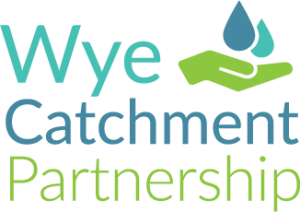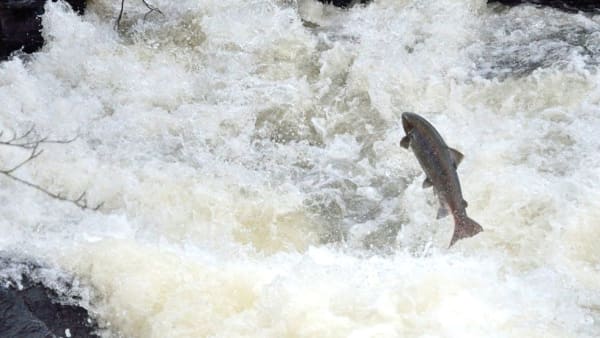Wednesday 3rd November, 2021
There is no denying that 2021 has been another extremely disappointing year for salmon anglers on both our rivers. While we will have to wait until sometime next year for Natural Resources Wales to publish the official Usk catch, it appears the Wye has probably had its worst season on record.
Despite this, the number and distribution of juvenile salmon found across the Wye and Usk in this year’s electrofishing survey of 194 sites has been more encouraging. In a year of seemingly endless bad news for rivers, these surveys have shown that the situation may not be quite as disastrous for our salmon as the rod catches of recent years would have us to believe.
Wye salmon
Some of the most positive results came from the upper river Lugg, a Wye tributary that is frequently in the media spotlight for the wrong reasons. Despite its headwaters being in relatively good shape, in recent years very few juvenile salmon have been recorded in these upper reaches. This was mainly due to Ballsgate weir at Aymestrey, a major barrier to migration for adult salmon attempting to spawn further upstream.
This year’s electrofishing results show that the larinier fish pass we completed at Ballsgate with the Environment Agency last year enabled plenty of salmon to ascend last winter and to repopulate the upper Lugg catchment. The wider distribution of juveniles will almost certainly result in much higher survival rates.
The pass and work on other Lugg weirs will also ease their downstream migration on their way out to sea, as it will for all fish species that would otherwise have been vulnerable to predation as they paused before descending weir. Other factors notwithstanding (such as sea survival), more adult salmon will return to the Lugg in the future as a result.

This year’s electrofishing surveys show that the fish pass the Foundation completed on Ballsgate weir with Environment Agency support in 2020 (above) enabled more salmon to spawn in the upper reaches of the river Lugg last winter. The habitat and water quality of this part of the catchment is very good (below left) and salmon fry were found in all but one of the sites surveyed this year upstream of the pass.


There was a similar story in the Monnow, which recorded its best distribution and numbers of salmon fry since the fish pass at Osbaston was completed in 2008. Salmon were recorded at the very top of the main stem Monnow and in the Olchon (one of its tributaries) for the first time. They were also recorded all the way down the length of the main stem.
However, while the results from the Monnow and Lugg sub-catchments were encouraging, the surveys confirmed that the upper catchment above Hay still provides most of the Wye’s salmon production.
 Usk salmon
Usk salmon
Three of the highest catches of juvenile salmon in our 2021 surveys came from upper Usk tributaries that have recently had their habitat improved (84 and 43 at two sites in the Nant Bran and 64 and 56 on two sites in the Crai). The Senni, another upper Usk tributary, also recorded good numbers of juveniles.
We also found salmon fry in the Rhiangoll (a tributary that joins the Usk near Crickhowell) for the first time since 2016. However, this stream was the exception for Usk tributaries below Brecon, where overall the numbers are still well down on those recorded in the early 2010s.
In recent years the Usk has become a catchment of two halves when it comes to salmon production. After the disastrous spawning winter of 2015/16, the numbers in the upper catchment are increasing but in the middle and lower river they remain inexplicably low.
The map above right shows the number of salmon juveniles found across the Wye and Usk catchments during this year’s electrofishing surveys in comparison to previous years. Please click on it to enlarge.
We have just received confirmation of support from the Ofwat Innovation Fund for a project that will focus on the Usk. A large part of this will be investigating the river’s water quality, temperature and flow regimes to give us a better understanding about what is happening and show what we have to do to correct the decline in Usk salmon.
Wye and Usk Trout
Across both catchments, juvenile trout numbers have been lower than expected for the second and in some areas, third year in a row. Their distribution is still good but numbers are falling. That this is happening in almost all parts of the Wye and Usk suggests a common factor might be causing this.
Trout are a long-lived species, usually spawning many times in their lifetime. Two poor years of recruitment will not adversely affect the fishery, especially in these days of high catch and release. However, we need to understand what needs to be done and to deliver it soon.

Coarse Fish
We would love to be able to carry out the same sort of assessments for coarse species but the problems of electrofishing accurately in the main river would make year-to-year comparisons difficult. We do have large numbers of anglers’ catch returns to assess but while they give us a good idea of numbers of adult fish, they do not necessarily give us a picture of recent juvenile recruitment.
However, there are worries about coarse fish numbers too, not least among anglers who send us their catch reports. The disappearance of ranunculus in the Wye will begin to affect all main stem fish species (if it is not already), the plant providing habitat and refuge for small coarse fish especially. New and as yet underdeveloped eDNA techniques may help us to make more accurate assessments of both coarse and salmonid fish stocks in the future but in the meantime, we will continue to focus our work on correcting water quantity and quality issues that are preventing ranunculus regrowth.

Surveying juvenile coarse fish in the main stems is difficult so assessments on fish stocks have to be made through angler catch returns instead. However, there are concerns for coarse fish recruitment too.
Returning to Atlantic salmon, what is also telling is that the numbers and distribution of juveniles across both catchments does not appear to reflect the rod catches for the preceding year. The number of salmon caught by anglers will have been negatively affected by severe algal blooms, floods, drought, high water temperatures and, of course, lower fishing effort, most notably with the Covid restrictions of the past two years.
So while it is undeniable that the salmon runs of both the Wye and Usk are nowhere near as strong as they could or should be, the juvenile counts are at least showing that all hope is not lost. The building blocks are in place for future runs of adult fish.

The graph above shows the average number of salmon juveniles from our survey sites for the past six years on the left against the preceding year’s rod catch rod catch on the right. A strong correlation might be expected but in reality, it appears to be an inverse relationship. This indicates that a low rod catch does not necessarily mean there has been a poor salmon run.
If poor water conditions are a major factor in fewer salmon being caught then it could be said that whatever fishery management technique is employed to add more fish, the rod catch will probably remain depressed until those conditions improve. A river that starts the year brown with soil, then turns green, then goes hot, then back to green and finishes brown again will never produce a good rod catch, even if it is full of fish.
The same issues that are depressing the rod catch are also damaging river ecology. This is something the Foundation is tasked to resolve. We are using our limited resources to find and implement measures that tackle large, complex and at times, daunting problems like algal blooms, excessive nutrients and extreme flows.
Solving them requires the involvement of a huge number of individuals and multiple organisations. It is not just about campaigning. Innovative, practical and workable solutions have to be devised and delivered if we are to increase the permeability of the land and reduce the amount of soil, nutrients and other pollutants entering the rivers.
We will report on the recent progress in this area of our work in an upcoming enews.



